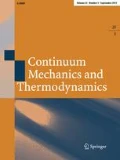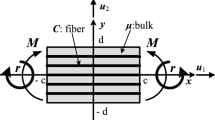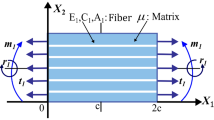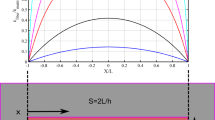Abstract
A second strain gradient theory-based continuum model is presented for the mechanics of an elastic solid reinforced with extensible fibers in plane elastostatics. The extension and bending kinematics of fibers are formulated via the second and the third gradient of the continuum deformation. The Euler equations arising in the third gradient of virtual displacement are then formulated by means of iterated integration by parts and variational principles. A rigorous derivation of the associated boundary conditions is also presented from which the expressions of triple forces and stresses are obtained. The obtained triple forces are found to be in conjugation with the Piola-type triple stress and are necessary to determine energy contributions on edges and points of Cauchy cuts. In particular, a complete linear model including admissible boundary conditions is derived within the description of superposed incremental deformations. The obtained analytical solution predicts smooth deformation profiles and, more importantly, assimilate gradual and dilatational shear angle distributions throughout the domain of interest.














Similar content being viewed by others
References
Spencer, A.J.M.: Deformations of Fibre-Reinforced Materials. Oxford University Press, Oxford (1972)
Pipkin, A.C.: Stress analysis for fiber-reinforced materials. Adv. Appl. Mech. 19, 1–51 (1979)
Landau, L.D., Lifšic, E.M.: Theory of Elasticity. Pergamon Press, London (1986)
Dill, E.H.: Kirchhoffs theory of rods. Arch. Hist. Exact Sci. 44, 1–23 (1992)
Antman, S.S.: Elasticity. Nonlinear Probl. Elast. Appl. Math. Sci. pp. 457–530 (1995)
Steigmann, D.J.: Theory of elastic solids reinforced with fibers resistant to extension, flexure and twist. Int. J. Non Linear Mech. 47, 734–742 (2012)
Kim, C.I.: Superposed incremental deformations of an elastic solid reinforced with fibers resistant to extension and flexure. Adv. Mater. Sci. Eng. 2018, 1–11 (2018)
Kim, C.I., Zeidi, M.: Gradient elasticity theory for fiber composites with fibers resistant to extension and flexure. Int. J. Eng. Sci. 131, 80–99 (2018)
Spencer, A., Soldatos, K.: Finite deformations of fibre-reinforced elastic solids with fibre bending stiffness. Int. J. Non Linear Mech. 42, 355–368 (2007)
Mulhern, J., Rogers, T., Spencer, A.: A continuum theory of a plastic-elastic fibre-reinforced material. Int. J. Eng. Sci. 7, 129–152 (1969)
Pipkin, A.C., Rogers, T.G.: Plane deformations of incompressible fiber-reinforced materials. J. Appl. Mech. 38, 634–640 (1971)
Dell’Isola, F., Giorgio, I., Pawlikowski, M., Rizzi, N.L.: Large deformations of planar extensible beams and pantographic lattices: heuristic homogenization, experimental and numerical examples of equilibrium. Philos. Trans. R. Soc. Lond. Ser. 472, 20150790 (2016)
Dell’Isola, F., Corte, A.D., Greco, L., Luongo, A.: Plane bias extension test for a continuum with two inextensible families of fibers: a variational treatment with Lagrange multipliers and a perturbation solution. Int. J. Solids Struct. 81, 1–12 (2016)
Dell’Isola, F., Cuomo, M., Greco, L., Corte, A.D.: Bias extension test for pantographic sheets: numerical simulations based on second gradient shear energies. J. Eng. Math. 103, 127–157 (2016)
Zeidi, M., Kim, C.I.: Finite plane deformations of elastic solids reinforced with fibers resistant to flexure: complete solution. Arch. Appl. Mech. 88, 819–835 (2017)
Zeidi, M., Kim, C.I.L.: Mechanics of an elastic solid reinforced with bidirectional fiber in finite plane elastostatics: complete analysis. Continuum Mech. Thermodyn. 30, 573–592 (2018)
Zeidi, M., Kim, C.I.: Mechanics of fiber composites with fibers resistant to extension and flexure. Math. Mech. Solids. 24, 3–17 (2017)
Islam, S., Zhalmuratova, D., Chung, H.-J., Kim, C.I.: A model for hyperelastic materials reinforced with fibers resistance to extension and flexure. Int. J. Solids Struct. 193–194, 418–433 (2020)
Javili, A., Dellisola, F., Steinmann, P.: Geometrically nonlinear higher-gradient elasticity with energetic boundaries. J. Mech. Phys. Solids. 61, 2381–2401 (2013)
Askes, H., Suiker, A.S.J., Sluys, L.J.: A classification of higher-order strain-gradient models—linear analysis. Arch. Appl. Mech. 72, 171–188 (2002)
Dell’Isola, F., Seppecher, P., Madeo, A.: How contact interactions may depend on the shape of Cauchy cuts in Nth gradient continua: approach “à la D’Alembert’’. Z. Angew. Math. Phys. 63, 1119–1141 (2012)
Dell’Isola, F., Corte, A.D., Giorgio, I.: Higher-gradient continua: the legacy of Piola, Mindlin, Sedov and Toupin and some future research perspectives. Math. Mech. Solids. 22, 852–872 (2016)
Romeo, F., Luongo, A.: Vibration reduction in piecewise bi-coupled periodic structures. J. Sound Vib. 268, 601–615 (2003)
Luongo, A., Romeo, F.: Real wave vectors for dynamic analysis of periodic structures. J. Sound Vib. 279, 309–325 (2005)
Marin, M., Nicaise, S.: Existence and stability results for thermoelastic dipolar bodies with double porosity. Continuum Mech. Thermodyn. 28(6), 1645–1657 (2016)
Muhammad, M., Marin, M., Ahmed, Z., Ellahi, R., Sara, I.: Swimming of motile gyrotactic microorganisms and nanoparticles in blood flow through anisotropically tapered arteries. Front. Phys. 8, 1–12 (2020)
Jasiuk, I., Ostoja-Starzewski, M.: Modeling of bone at a single lamella level. Biomech. Model. Mechanobiol. 3, 67–74 (2004)
Andreaus, U., Giorgio, I., Madeo, A.: Modeling of the interaction between bone tissue and resorbable biomaterial as linear elastic materials with voids. Z. Angew. Math. Phys. 66, 209–237 (2014)
Giorgio, I., Andreaus, U., dell’Isola, F., Lekszycki, T.: Viscous second gradient porous materials for bones reconstructed with bio-resorbable grafts. Extreme Mech. Lett. 13, 141–147 (2017)
Mindlin, R.: Second gradient of strain and surface-tension in linear elasticity. Int. J. Solids Struct. 1, 417–438 (1965)
Luongo, A., Piccardo, G.: Non-linear galloping of sagged cables in 1:2 internal resonance. J. Sound Vib. 214, 915–940 (1998)
Luongo, A., Piccardo, G.: Linear instability mechanisms for coupled translational galloping. J. Sound Vib. 288, 1027–1047 (2005)
Paolone, A., Vasta, M., Luongo, A.: Flexural-torsional bifurcations of a cantilever beam under potential and circulatory forces I: non-linear model and stability analysis. Int. J. Non Linear Mech. 41, 586–594 (2006)
Kim, C.I., Islam, S.: Mechanics of third-gradient continua reinforced with fibers resistant to flexure in finite plane elastostatics. Continuum Mech. Thermodyn. 32, 1595–1617 (2020)
Bolouri, S.E.S., Kim, C.I., Yang, S.: Linear theory for the mechanics of third-gradient continua reinforced with fibers resistance to flexure. Math. Mech. Solids. 25, 937–960 (2019)
Germain, P.: The method of virtual power in continuum mechanics. Part 2: microstructure. SIAM. J. Appl. Math. 25, 556–575 (1973)
Dell’Isola, F., Seppecher, P.: The relationship between edge contact forces, double forces and interstitial working allowed by the principle of virtual power. C. R. Acad. Sci. IIb. Mec. Elsevier, p. 7 (1995)
Alibert, J.J., Seppecher, P., Dell’Isola, F.: Truss modular beams with deformation energy depending on higher displacement gradients. Math. Mech. Solids. 8, 51–73 (2003)
Read, W.: Series solutions for Laplaces equation with nonhomogeneous mixed boundary conditions and irregular boundaries. Math. Comput. Modell. 17, 9–19 (1993)
Read, W.: Analytical solutions for a Helmholtz equation with Dirichlet boundary conditions and arbitrary boundaries. Math. Comput. Modell. 24, 23–34 (1996)
Huang, Y., Zhang, X.-J.: General analytical solution of transverse vibration for orthotropic rectangular thin plates. J. Mar. Sci. Appl. 1, 78–82 (2002)
Dell’Isola, F., Steigmann, D.: A two-dimensional gradient-elasticity theory for woven fabrics. J. Elast. 118, 113–125 (2014)
Mindlin, R.D., Tiersten, H.F.: Effects of couple-stresses in linear elasticity. Arch. Ration. Mech. Anal. 11, 415–448 (1962)
Toupin, R.A.: Theories of elasticity with couple-stress. Arch. Ration. Mech. Anal. 17, 85–112 (1964)
Koiter, W.T.: Couple-stresses in the theory of elasticity. Proc. K. Ned. Akad. Wetensc. 67, 17–44 (1964)
Steigmann, D.J.: Finite Elasticity Theory. Oxford University Press, Oxford (2017)
Ogden, R.: Non-linear Elastic Deformations, vol. 1, p. 119. Courier Corporation, Chelmsford (1984)
Bersani, A., dell’Isola, F., Seppecher, P.: Lagrange multipliers in infinite dimensional spaces, examples of application. In: Altenbach, H., Ochsner, A. (eds.) Encyclopedia of Continuum Mechanics. Springer, Berlin (2019)
England, A.H.: Complex Variable Methods in Elasticity. Wiley, London (2013)
Timoshenko, S.P., Goodier, J.: N: Theory of Elasticity, 3rd edn. McGraw Hill, London (2010)
Muskhelishvili, N.I.: Some Basic Problems of the Mathematical Theory of Elasticity. P. Noordhof, Groningen (1963)
Kim, C.I.: Strain-gradient elasticity theory for the mechanics of fiber composites subjected to finite plane deformations: comprehensive analysis. Multiscale Sci. Eng. 1, 150–160 (2019)
Reiher, J.C., Giorgio, I., Bertram, A.: Finite-element analysis of polyhedra under point and line forces in second-strain gradient elasticity. J. Eng. Mech. 143(2), 04016112-1–13 (2017). https://doi.org/10.1061/(ASCE)EM.1943-7889.0001184
Giorgio, I.: Lattice shells composed of two families of curved Kirchhoff rods: an archetypal example, topology optimization of a cycloidal metamaterial. Continuum Mech. Thermodyn. (2020). https://doi.org/10.1007/s00161-020-00955-4
Giorgio, I., Ciallella, A., Scerrato, D.: A study about the impact of the topological arrangement of fibers on fiber-reinforced composites: Some guidelines aiming at the development of new ultra-stiff and ultra-soft metamaterials. Int. J. Solids Struct. 203, 73–83 (2020)
Acknowledgements
This work was supported by the Natural Sciences and Engineering Research Council of Canada via Grant #RGPIN 04742 and the University of Alberta through a start-up Grant. Kim would like to thank Dr. David Steigmann for stimulating his interest in this subject.
Author information
Authors and Affiliations
Corresponding author
Additional information
Communicated by Andreas Öchsner.
Publisher's Note
Springer Nature remains neutral with regard to jurisdictional claims in published maps and institutional affiliations.
Appendix
Appendix
\(\bullet \) Algebraic procedures for \(a_{m},b_{m},c_{m}\) and \(d_{m}\)
\(\bullet \) Evaluation of the geodesic curvature of the fibers
The geodesic curvature of a parametric curve (\(\mathbf {r}(S)\)) can be obtained by evaluating the second derivative of \(\mathbf {r}(S)\) with respect to the arc length parameter (S);
Using the chain rule (i.e., \(\mathrm{{d}}(*)/\mathrm{{d}}S=\frac{\mathrm{{d}}(*)}{\mathrm{{d}}\mathbf {X}}\frac{\mathrm{{d}} \mathbf {X}}{\mathrm{{d}}S}\)), we obtain from Eq. (A2) that
Since \(\mathbf {F}=\mathrm{{d}}\varvec{\chi }/\mathrm{{d}}\mathbf {X}\) and \(\mathbf {D}=(\mathrm{{d}}\mathbf {X} (S))/\mathrm{{d}}S\), the above can be rewritten as
where \(\nabla (\mathbf {FD})=\mathrm{{d}}(\mathbf {FD})/\mathrm{{d}}\mathbf {X}\) is the first gradient of “ \(\mathbf {FD}\)” .
\(\bullet \) Evaluation of the rate of changes in curvature of the fibers
The rate of changes in curvature of the fibers can be formulated by taking third derivative of \(\mathbf {r}(S)\) with respect to the arc length parameter (S). Hence, from Eq. (A4), we find
Now applying the chain rule (i.e., \(\mathrm{{d}}(*)/\mathrm{{d}}S=\frac{\mathrm{{d}}(*)}{\mathrm{{d}}\mathbf {X}} \frac{\mathrm{{d}}\mathbf {X}}{\mathrm{{d}}S}\)), Eq. (A5) Becomes
Since \(\mathbf {D}=(\mathrm{{d}}\mathbf {X}(S))/\mathrm{{d}}S\), the above can be rewritten as
where \(\nabla (\nabla (\mathbf {FD}))=\mathrm{{d}}^{2}(\mathbf {FD})/\mathrm{{d}}\mathbf {X}^{2}\) is the second gradient of “ \(\mathbf {FD}\) ”.
\(\bullet \) Implementation of the boundary conditions [Eq. (53)]
The boundary conditions in Eq. (53) can be readily implemented in the desired boundaries via the tangential and normal vectors of the boundary and the director field of the fibers. For example, in the case of aligned fibers in the direction of \(\mathbf {X}_{1}\), we find
Now on \(\Omega _{1}\), the unit normal and tangent to the boundary are defined by (see Fig. 15)
Hence, on \(\Omega _{1}\), the corresponding boundary conditions can be obtained by
where \(\mathbf {t}^{1}=t_{1}^{1}\mathbf {e}_{1}+t_{2}^{1}\mathbf {e}_{2}\), \( \mathbf {m}^{1}=m_{1}^{1}\mathbf {e}_{1}+m_{2}^{1}\mathbf {e}_{2}\) and \(\mathbf { r}^{1}=r_{1}^{1}\mathbf {e}_{1}+r_{2}^{1}\mathbf {e}_{2}\) are, respectively, the boundary traction, edge moment and the triple force acting on the \( \Omega _{1}\) boundary.
For \(\Omega _{2}\) boundary, we find (see Fig. 15)
Therefore, repeating the same process as done in the above, it can be shown that
Lastly, Eq. (A12) indicates that the edge moment and triple force cannot be sustained by the \(\Omega _{2}\) boundary where no reinforcing fibers are aligned in \(\mathbf {e}_{2}\) direction.
Rights and permissions
About this article
Cite this article
Bolouri, S.E.S., Kim, Ci. A model for the second strain gradient continua reinforced with extensible fibers in plane elastostatics. Continuum Mech. Thermodyn. 33, 2141–2165 (2021). https://doi.org/10.1007/s00161-021-01015-1
Received:
Accepted:
Published:
Issue Date:
DOI: https://doi.org/10.1007/s00161-021-01015-1





